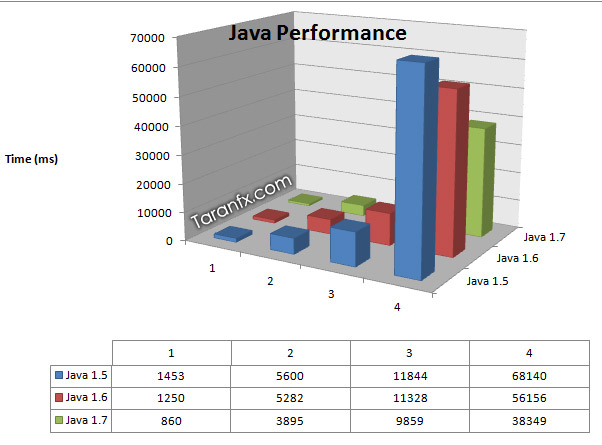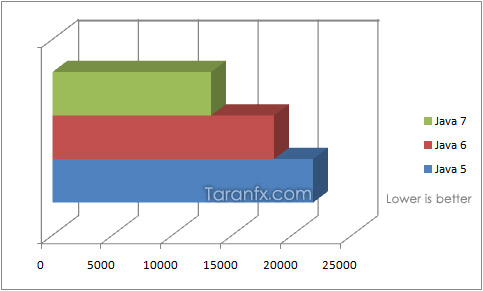 Java is one of the language which has overhauled it’s underneath technology ground-up. Even though, the basic concept of running inside JVM holds good, the way JVM handles Objects, Memory management has completely been revamped.
Java is one of the language which has overhauled it’s underneath technology ground-up. Even though, the basic concept of running inside JVM holds good, the way JVM handles Objects, Memory management has completely been revamped.
A lot changed over 1.4 to 1.5. There were critical compile-time improvements, Runtime smartness and with Java 6 more performance optimizations; Java 7 – the modularity.
Let’s start discussing each aspect of Java 7 which makes it go Loud -
- Modularization – JSR 294 or Project Jigsaw
- JVM Support for dynamic languages
- More New I/O APIs which are nearly finished, includes true asynchronous I/O and finally a real file system API – JSR 203
- The native language support for XML. (probable)
- Safe rethrow – Allows a broad catch clause, with the compiler being smarter on what you’re allowed to rethrow based on what is thrown from the try block. (I had not seen this before but it looks nice)
- Null dereference expressions – Null checks with ‘?’ syntax similar to Groovy… lettign developers avoid a nest of null checks.
- Better type inference – Example around generics instantiations, but it was not clear how far the inference would be taken (the more the better in my opinion).
- Multi-catch - Allows a comma separated list of disjunctive exception types in catch clause.
- JSR 296 – Swing application framework – It still needs to be easier to create Swing apps.
Update: As per Sun Blogs
The “Small” Sun changes are:
- Upgrade class loader architecture – Work started in Java 5 and continues to evolve. There are some deadlock issues today in classloader delegation that will be addressed.
- XRender pipeline for Java 2D – This was an Open JDK Integrators Challenge project,and is an analog to the OpenGL pipeline but much more portable across x11.
- Swing Updates – JXLayer, DatePicker, CSS styling (maybe) that Ethan Nicholaus (sp?) has been working on
- JavaFX
Update: Few new Small changes of “Project coin” are available here.
The “Fast” changes from Sun (This refers to performance improvements):
Hotspot run-time compiler enhancements
- A couple of concurrency (JSR 166) tweaks (Better support for Multicore)
- G1 Garbage collector- Leads to much smaller pause times and hopes to replace CMS (Concurrent mark sweep) GC
- Compressed pointer 64 bit VM
- MVM-lite – Multiple Virtual Machines will help run isolated applications and allow a kill -9 on a Java application. Mark said it is not clear what problem would be solved, and original project was extremely ambitious, but desire to drag apps out of browser plugin presents a good usage and need for MVM. (This could be moved to a later release)
The Theory and Practical
As far as what changes you’ll see in your day-to-day work, my guess is that the major impact will be stuff like JSR 203 which overhauls the file system API. If JSR 310 is included, then it would also have a major impact on how you interact with any aspect of the date and time APIs. Many of the other JSRs will only impact you if you happen to already do something in that particular area (JMX – JSR 255, concurrency – JSR 166, etc).
The biggest thing most people will notice may be performance. This is my favorite. And that is exactly what I thought about writing, and it expanded the scope to features aswell. As usual, each JDK brings a whole new set of performance optimizations. We’ve already seen some very encouraging results in String performance, array performance, and a new concurrent garbage collector (G1). I suspect many people will find that their existing code will work and run noticeably faster than it did in the past.
Performance
I saw this one about the new features in Java 7:
http://www.ibm.com/developerworks/java/library/j-jtp03048.html
They use MergeSort as an example of how to exploit multiple CPUs for sorting. Java 7 has the nice feature, that it can now decide at runtime, how many threads should be used to solve a particular problem (see the coInvoke part).
However, there is this tricky constant, SEQUENTIAL_THRESHOLD, which is used to decide whether to enforce sequential processing or not. How do you set this value? Well, you set it at design time, even though the example was meant to show how Java adapts at runtime…
The next thing is that the whole array is passed as parameter. No matter what programming language you use, this is a bad design. If Java doesn’t copy the memory, you may have 2 CPUs looking at the same RAM area. If Java has a runtime optimization that detects that 2 CPUs are looking at the same area, and decides to copy the data, it will copy too much data…
I’m not sure this example would perform better on a 4-CPU machine than on a single-CPU machine with the same CPUs…
The basic problem in all this is, that it is extremely hard to find real world examples of parallelization of algorithms that can be optimized to any kind of parallel hardware. Good multi-threading must be done on a functionality level, not on the algorithm level.
Also, every time we add multi-threading to code, we make it more complex. In other words, it comes at a cost. I predict that some of the future performance gains don’t come from making algorithms more threaded, but from changing data structures, reducing memory footprint and simple optimizations. As the price of more performance increases, efforts will be spent where most speed can be gained at the lowest price.
Benchmarking JDK 7
As per Sun, The JDK 7 delivers quite a speed boost over JDK 6 array accesses. For us, this is huge. It’s like another year and a half of Moore’s law for free. Only in software. And you don’t even have to write multi-threaded code.
It’s basically a stress test that I used for ArrayLists, HashMaps, gets, array sets, and simple multiply-add-subtract, arithmetic, and concurrency APIs, Threads.
I installed the following beta release of JDK 7:
> java -version java version "1.7.0-ea" Java(TM) SE Runtime Environment (build 1.7.0-ea-b66) Java HotSpot(TM) Client VM (build 16.0-b06, mixed mode, sharing)
Java has always suffered relative to C/C++ in matrix multiplication because Java does range checks on every array access (set or get). With some clever static and run-time analysis, we are able to eliminate most of the array bounds checks. They show on matrix benchmarks that this one improvement doubles the speed of the LU matrix factorization benchmark in the U.S. National Institute of Standards (NIST) benchmark suite SciMark 2, which like our clustering algorithm, is basically just a stress test for array access and arithmetic.
I’m pretty excited about the new fork-join concurrency, too, as it’s just what we’ll need to parallelize the inner loops without too much work for us or the operating system.
I decided to take my on Test-check for performance for Java 7 and then compare it with 5, 6.
My tests have been on a Dell D630 Notebook running Windows 7 RTM (32 bit) with an Intel Core 2 CPU (2.4GHz), and 3GB of RAM.
Here are the Benchmark Tests -
Test 1. Add 5 Million String values (each calculated with some complex Math arithmetic)
Test 2. ArrayList <String> with 5 Million insertions (with values from Test1). Insertions are conditional and have additional computation before adding to array.
Test 3. HashMap <String, Integer> with 5 million keys, values. Each key, value pair is being calculated via concurrent thread. (This tread tests both Arithmetic and concurrency capabilities)
Test 4. Printing 5 million items of ArrayList <String> to number of Files (1000) and Reading back again. (Tests multicore concurrency to the edge) My CPU, HDD, RAM all went to Max.
All of these tests were very memory intensive. Heap size varied between 1 – 2 GB during tests, due to large no. of objects. CPU Utilization was sometimes 50% (1 core’s max) and most of the time >70% and in Test3, Test4; CPU touched 100% most of the times.
The Result is mind blowing!

And the Result The Winner is … Java 7
Java 5 <=== 18% faster=== < Java 6 < ===46% faster===< Java 7
 Note – This was totally based upon my tests, doesn’t necessarily means it’s for overall Java. The results may vary for different kinds of computations.
Note – This was totally based upon my tests, doesn’t necessarily means it’s for overall Java. The results may vary for different kinds of computations.







相关推荐
JDK7安装包.zip\JDK7安装包.zip\JDK7安装包.zip\JDK7安装包.zip\JDK7安装包.zip JDK7安装包.zip\JDK7安装包.zip\JDK7安装包.zip\JDK7安装包.zip\JDK7安装包.zip JDK7安装包.zip\JDK7安装包.zip\JDK7安装包.zip\JDK7...
jdk7j下载jdk7j下载jdk7j下载jdk7j下载jdk7j下载jdk7j下载jdk7j下载jdk7j下载jdk7j下载jdk7j下载jdk7j下载jdk7j下载jdk7j下载
jdk7 jdk8 jdk9 jdk10 jdk11 jdk12 jdk13 jdk14 (win-64位) 资源共享
jdk-7u80-windows-x64安装包 jdk-7u80-windows-x64安装包 jdk-7u80-windows-x64安装包 jdk-7u80-windows-x64安装包 jdk-7u80-windows-x64安装包 jdk-7u80-windows-x64安装包 jdk-7u80-windows-x64安装包 jdk-7u80-...
jdk7chm,java7帮助,jdk7api,jdk1.7帮且文档,jdk7api chm,JDK(Java Development Kit)是Sun Microsystems针对Java开发员的产品。自从Java推出以来,JDK已经成为使用最广泛的Java SDK。JDK 是整个Java的核心,包括了...
jdk7 jdk-7u80-linux-x64 网盘下载
1.1 JDK7新特性<一>概述 . . . . . . . . . . . . . . 1.2 JDK7新特性<二> 语法 . . . . . . . . . . . . . 1.3 JDK7新特性<三> JDBC4.1 . . . . . . . . . . 1.4 JDK7新特性<四> NIO2.0 文件系统 . . . 1.5 JDK...
jdk7,openjdk7,适用于arm64、aarch64架构linux等国产化服务器,如银河麒麟V10、uos等服务器系统。 详细信息 jdk7 arm64 aarch64 。亲测可用。
jdk7免安装版,可以正常使用,有问题可以联系我,JDK(Java Development Kit)就是Java的开发工具包,无论是开发javase,javaee,javaee.是给Java开发者必须用到的开发工具
jdk-7u80-windows-x64.exe 【官方下载的jdk1.7、jdk7,windows 64位版】
官网 jdk6,jdk7,jdk8,jdk9,jdk10 windox 32位、64位、linux 32位、64位 百度云。
JDK1.7最终版,jdk-7u80,包含文件如下: jdk-7u80-linux-i586.gz jdk-7u80-linux-x64.tar.gz jdk-7u80-windows-i586.exe jdk-7u80-windows-x64.exe
jdk-7u79-windows-i586.exe JDK7 稳定版 源官方下载地址: http://www.oracle.com/technetwork/java/javase/downloads/jdk7-downloads-1880260.html
JAVA JDK7 1.7.80 Windows 32位版本,生产环境中亲自安装好用。
jdk7安装包jdk7安装包jdk7安装包jdk7安装包jdk7安装包jdk7安装包jdk7安装包
Mac版的jdk7,官网好像不好下,得登录Mac版的jdk7,官网好像不好下,得登录Mac版的jdk7,官网好像不好下,得登录Mac版的jdk7,官网好像不好下,得登录Mac版的jdk7,官网好像不好下,得登录Mac版的jdk7,官网好像不好...
linux平台的64位版本jdk7,官方原版,hash可匹配验证 。
Java JDK 7学习笔记 PDF
kettle jar包, jdk7版本和jdk8版本 kettle jar包, jdk7版本和jdk8版本
jdk7 32位最新版本,官网下载jdk7 32位最新版本,官网下载jdk7 32位最新版本,官网下载jdk7 32位最新版本,官网下载jdk7 32位最新版本,官网下载jdk7 32位最新版本,官网下载